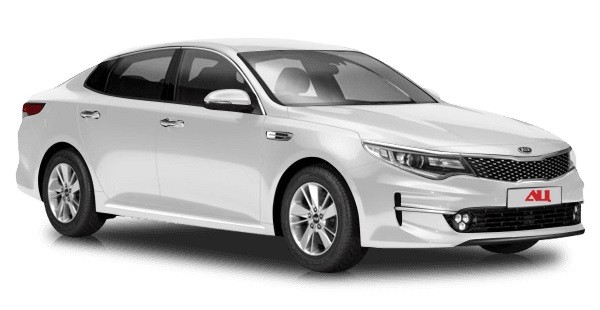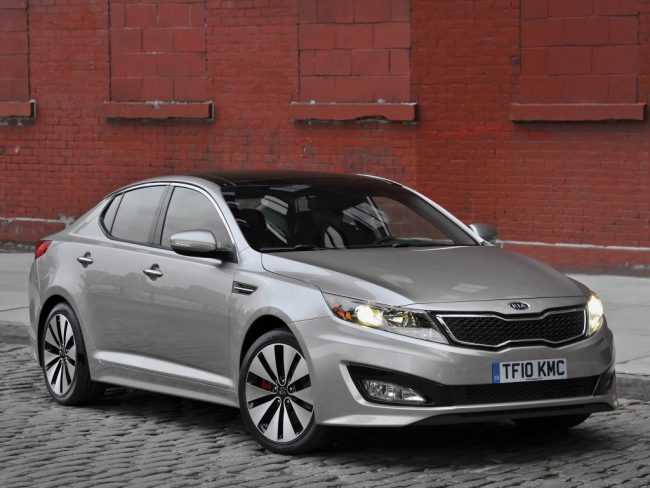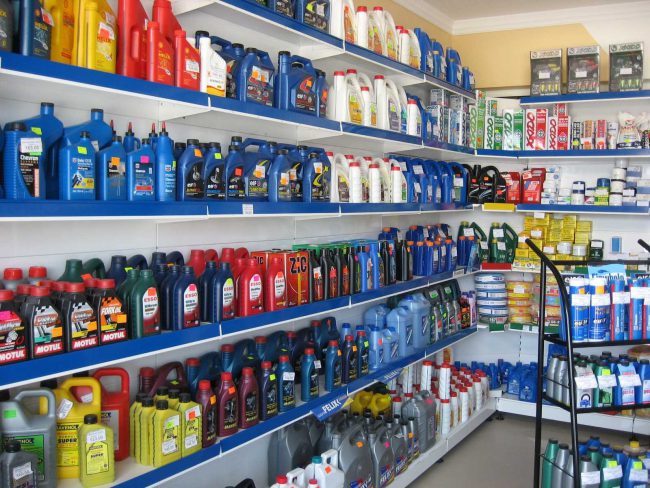
Kia Optima engines
Content
Kia Optima is a 4-door mid-size sedan from South Korean manufacturer Kia Motors Corporation. The car has been in production since 2000. The Optima name was used primarily for the 1st generation model. Since 2002, the car has been sold in Europe and Canada under the designation Kia Magentis.
Since 2005, the model has been sold worldwide under the same name, with the exception of the United States and Malaysia. There she retained the traditional name - Optima. In the South Korean and Chinese market segment, the car is sold under the designation Kia Lotze & Kia K5. Starting from the end of 2015, the 4th generation of the model went on sale. A modification of the 4-door station wagon was added to the 5-door sedan.
Initially (in the 1st generation), the car was produced as a converted version of the Hyundai Sonata. The differences were only in the details of design and equipment. In 2002, its updated luxurious South Korean version was released. In the second generation, the car was already based on a new, global platform, referred to as "MG". An updated version was released in 2008.
 Since 2010, the 3rd generation of the model has been based on the same platform as the Hyundai i40. In the same generation, hybrid and turbocharged versions were jointly released. At the end of 2015, the manufacturer introduced the 4th generation of the model with a completely new design and functionality. The car has the same base with the Hyundai Sonata.
Since 2010, the 3rd generation of the model has been based on the same platform as the Hyundai i40. In the same generation, hybrid and turbocharged versions were jointly released. At the end of 2015, the manufacturer introduced the 4th generation of the model with a completely new design and functionality. The car has the same base with the Hyundai Sonata.
What engines were installed on different generations of cars
| Features | 4EA | G4KA | G4KD | G6EA | G4KF | G4KJ |
|---|---|---|---|---|---|---|
| Volume, cm 3 | 1990 | 1998 | 1997 | 2657 | 1997 (turbine) | 2360 |
| Maximum power, l. With. | 125-150 | 146-155 | 146-167 | 190-194 | 214-249 | 181-189 |
| Maximum torque, N * m (kg * m) at rpm. | 290 (29)/2000 - 351 (36)/2500 | 190 (19)/4249 - 199 (20)/4599 | 191 (19)/4599 - 197 (20)/4599 | 246 (25)/4000 - 251 (26)/4500 | 301 (31)/1901 - 374 (38)/4499 | 232 (24)/4000 - 242 (25)/4000 |
| Type of fuel | Diesel | Gasoline, AI-95 | Gasoline, AI-92, AI-95. | Gasoline AI-95 | Gasoline, AI-95. | Gasoline AI-95 |
| Consumption for 100 km | 7-8 (4 for turbo) | 7,7-8,5 | 08.12.2018 | 09.10.2018 | 8,5-10,2 | 8.5 |
| Motor type | Inline, 4 cylinders, 16 valves. | Inline, 4 cylinders, 16 valves. | Inline, 4 cylinders, 16 valves. | V-shaped, 6 cylinders. | Inline, 4 cylinders. | Inline, 4 cylinders. |
| Carbon dioxide emissions, g/km | 150 | 167-199 | ||||
| Compression ratio | 17 (for turbo modification) | |||||
| Auto generation | Second | Second, restyling in 2009 | Second, third, fourth. Restyling of the second and third. | Second generation, restyling 2009 | Fourth sedan 2016 | Fourth sedan 2016 Third generation restyling 2014 |
Most popular engines
Each generation of the Kia Optima model has its own characteristics, including the installed power unit. Consider the features of those modifications that have received the maximum distribution.
First generation
In the first generation, the car was called Magentis MS. Its production belonged to two companies - Hyundai and Kia. The car was equipped with three modifications of the engine - a 4-cylinder 2-liter, with a capacity of 134 liters. with., V-shaped 6-cylinder 2,5-liter power of 167 liters. With. and V-shaped with six cylinders of 2,6 liters with a capacity of 185 liters. With.
The most popular option among them was the 2-liter unit.
The main reason for this is economy, sufficient power, ease of maintenance and a reliable fuel injection control system. 6-cylinder engines, although they were superior in power and torque, however, lost a lot in dynamics and fuel consumption.
In fact, they would fit 2-ton vehicles.
Speaking about the practical characteristics, it can be noted that all 3 engine modifications were distinguished by a long service life and maintainability. The high quality of materials, simplicity of design and execution make such units work without interference for more than a hundred thousand kilometers.
The second generation
In the second generation of Kia Optima, a new diesel unit was added. With a volume of 2 liters, it produces 140 liters. With. at a torque of 1800-2500 Nm / rev. min. The new engine proved to be a worthy competitor to gasoline internal combustion engines. First of all, this affected such important parameters as traction and economy.
However, despite the survivability and good performance, the engines of this series force the owners of the cars on which they are installed to pay more attention to maintenance. This includes more frequent replacement of consumables, and high requirements for the quality of fuels and lubricants.
A significant problem that occurred during the operation of such a unit on the Kia Optima was caused by particulate filters.
They eventually become clogged, and the only thing that can save the day is to remove them completely. The difficulty lies also in the fact that a reinstallation of the software control is required. However, this procedure has its own advantage. With the right approach, you can increase the engine power by 35-45 hp. With.
Third Generation
The third-generation Kia Optima ICE series included a predominantly atmospheric unit and turbo engines from 2 to 2,4 liters, as well as a turbocharged 1,7-liter diesel engine. Mitsubishi Theta 2 power plants include 4 cylinders with an aluminum block, have an injection system, 4 valves per cylinder, run on AI-95 gasoline and are characterized by the Euro-4 standard.
 The manufacturer gives a guarantee for 250 thousand kilometers to its motors. Compared to previous versions, the new engines have an improved gas distribution system - CVVT, improved attachments and software.
The manufacturer gives a guarantee for 250 thousand kilometers to its motors. Compared to previous versions, the new engines have an improved gas distribution system - CVVT, improved attachments and software.
The most successful modification from this series was a 2-liter unit. Due to good traction, a relatively low level of operating noise and high reliability, it began to be installed not only on Kia Optima, but also on models from other manufacturers - Hyundai, Chrysler, Dodge, Mitsubishi, Jeep.
A 2-liter unit at 6500 rpm develops power up to 165 hp. s., although for the Russian market it is cut to 150 liters. With. The motor lends itself perfectly to tuning. With the correct flashing, the potential of the motor develops over 190 hp. With. The 2,4-liter engine has similar characteristics and popularity.
Their only design flaw is the lack of hydraulic lifters. Therefore, every 100 thousand kilometers, it is necessary to adjust the valves.
Fourth generation
In the fourth generation (modern version), Kia Optima is equipped with a new ICE model range. These are primarily gasoline units:
- 0 MPI. It has a power of 151 liters. With. at 4800 rpm min. Comes with manual and automatic transmission. The motor is installed on the Classic (mechanics) and Comfort, Luxe, Prestige (all 3 automatic) configurations. Fuel consumption does not exceed 8 liters per 100 km.
- 4 GDIs. It has a capacity of 189 liters. With. at 4000 rpm min. Equipped with a direct fuel injection system. The unit is installed on the Prestige, Luxe and GT-line configurations. Consumes no more than 8,5 liters of fuel per 100 kilometers.
- 0 T-GDI turbocharged. Develops about 250 liters. With. with a torque of about 350 Nm. Installed on the GT package. A car consumes about 100 liters of fuel per 8,5 km. This is the most powerful engine modification available today for the Kia Optima. A car equipped with such an internal combustion engine acquires a sporty character. So, acceleration to 100 km / h is carried out in just 7,5 seconds, and for the tuned version - in 5 seconds!
The entire line of motors for Kia Optima meets the highest quality and reliability requirements. The units of the manufacturer Mitsubishi were taken as a basis. Having retained the base and supplemented them with the latest developments, the company has released a number of different internal combustion engines.
In general, engines have few drawbacks. They work on gasoline fuel AI - 92/95. Differ in good dynamics, force and profitability. The natural price for such characteristics is the timely care and selection of high-quality consumables, fuel and, especially, engine oil.
Engine oil selection
A competent choice of engine oil will allow the car engine to function without serious problems for more than one hundred thousand kilometers. And on the contrary, pouring even high-quality oil, but not corresponding to the operating conditions and features of the motor, can quickly disable the latter.  Therefore, it is so important to observe the following minimum set of rules when choosing engine oil for Kia Optima:
Therefore, it is so important to observe the following minimum set of rules when choosing engine oil for Kia Optima:
- SAE viscosity index. It characterizes the uniformity of oil distribution over the inner surface of the motor. The larger its value, the higher the viscosity of the oil and the greater the resistance to thermal overload. Affects the parameters of the warm-up time and start to cold.
- API and ACEA certificates. Determine the fuel consumption, the durability of the catalyst, the level of noise and vibration.
- Compliance with ambient temperature. Some types of oils are designed for the heat, others for the winter.
- Number of turns.
There is no universal engine oil for Kia Optima. Therefore, each car owner must take into account the operating conditions and, in accordance with them, select oil according to one or another priority feature - according to the time of year, the degree of engine wear, fuel economy, and so on.
Which engine is better to choose a car
When buying a Kia Optima car, the future car owner is faced with the question of which engine option to opt for. First of all, we are talking about a car that is being produced at the moment, that is, the 4th generation. Three versions are presented for the choice of the domestic consumer - 2-, 2,4-liter and turbo version.
Here, the buyer needs to take into account the conditions under which he plans to operate his future car, how much money he is willing to pay, including tax fees for l. with., how much he plans to spend on refueling and consumables.
For example, a turbocharged modification is suitable for those who are accustomed to sports driving, as well as those who plan to subject the engine to further improvements, bringing the unit to a record-breaking dynamics in its segment - acceleration to “hundredths” in 5 seconds.
Otherwise, if the driver is not used to it or he simply has nowhere to master dynamic driving, the first two versions will do. At the same time, the 2-liter option is the most economical and quite sufficient in terms of power for moving around the city. For those who are going on long trips or a business trip, a more powerful and voluminous 2,4-liter engine is better suited.
If we talk about engines of earlier versions, then everything is decided by the preferences of the owner of the car. Diesel units have always been considered the most economical. However, their level of environmental friendliness is always lower than that of gasoline. This is especially true for those who are going to travel on European roads. In addition, the operating parameters of a diesel engine are significantly affected by the level and quality of fuel, which in Russian conditions is not always up to par.

